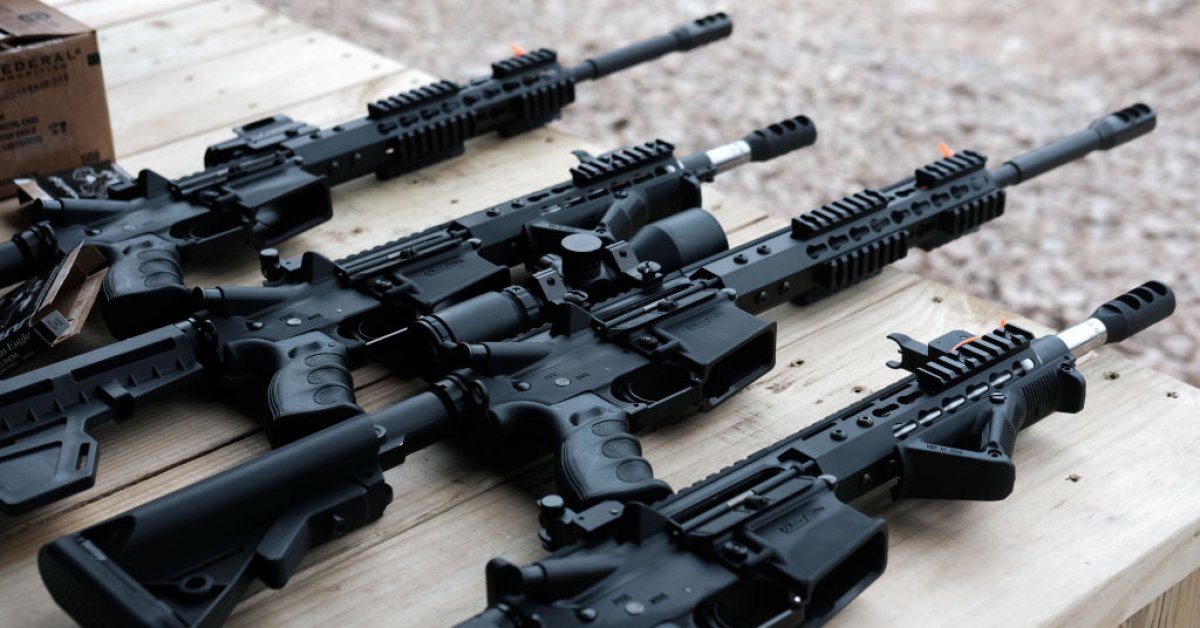
The Washington State house approved a sweeping assault weapons ban on Wednesday that would prohibit the sale and manufacture of all AR-15 and AK-47 rifles and many other popular semi-automatic weapons. If passed, it would impose some of the strictest restrictions on assault weapons in the country.
Legal experts, however, say that courts would likely strike down the law after the Supreme Court signaled it would apply tough constitutional standards to gun restrictions in a ruling last June.
Washington state’s bill is broad in the kinds of guns it covers. It would ban entire classes of guns, including AK-74, AK-47, AR-15, M-16, and M-4 models in all forms and “regardless of which… company produced and manufactured the firearm.” It also lists dozens of specific models that would be banned, as well as banning semi-automatic firearms with multiple accessories that are now common, including telescoping stocks, threaded barrels for muzzle brakes, flash suppressors or silencers, and pistol grips. Magazines that hold more than 10 rounds of ammunition would also be banned.
The bill bans the sale, manufacture, and import of such weapons in the state but does not explicitly ban possession—meaning it would apply to new firearms, but not affect existing owners. It also has some exceptions for law enforcement and the military.
About nine states and D.C. currently restrict assault weapons; they include California, Connecticut, Delaware, Hawaii, Illinois, Maryland, Massachusetts, New Jersey, and New York, according to the Giffords Law Center to Prevent Gun Violence. The laws vary on which firearms they classify as assault weapons as well as restrictions on the sale, manufacture or possession of these guns.
The legislation is backed by Washington Governor Jay Inslee, who was on the floor during its passage, the Seattle Times reported. The legislation succeeded on a straight party line vote and now heads to the Senate, where Democrats have a majority.
State Democrats supporting the bill pointed to a steady stream of mass shootings in the U.S. in advocating for its passage. The legislation highlights an analysis of mass shootings that result in four or more deaths; 85% of those fatalities were caused by an assault weapon, according to the Giffords Law Center to Prevent Violence. Republicans say the measure is too broad and will likely be struck down by courts.
Legal mostly experts agree with the assessment from Washington State Republicans. That’s due to the Supreme Court’s strict ruling last June in New York State Rifle & Pistol Association Inc. v. Bruen, in which the court ruled that Americans had a right to carry firearms in public for self-defense. Justice Clarence Thomas, who authored the majority opinion, ruled more broadly that gun-related measures would only be constitutional if they are “consistent with this nation’s historical tradition” and have similar regulations during the time the Constitution was framed.
Even though most federal courts have previously upheld bans on so-called assault weapons, which gun rights groups say is an arbitrary label that targets gun features and accessories, many of the rulings came before the high court took a more expansive view of the Second Amendment, says Adam Winkler, a law professor at UCLA and expert on gun policy. “[The New York State Rifle and Pistol Association ruling] fundamentally changed Second Amendment doctrine and made it much harder for gun laws like assault weapons bans to survive,” Winkler says.
“The Supreme Court said that for a gun law today to be constitutional, it has to be consistent with the gun laws of the 1700s and 1800s—and, of course, assault weapon bans were not commonplace then. Assault weapons themselves were not commonplace,” Winkler says.
Another restriction from the Supreme Court is the “common use” test and the idea that the Second Amendment protects firearms in common use by the law-abiding public. AR-15-style rifles, like those targeted in Washington’s assault weapons ban, are by many accounts the most popular rifles in America—at a time when gun ownership rates are surging.
Robert Cottrol, a law professor at George Washington University and gun policy expert, says the bill’s measure targeting the sale of large-capacity magazines makes sense because it’s easy to buy magazines that hold more ammunition, even if a gun is sold with a smaller magazine. But he questions whether some of the provisions in the bill target features that are more cosmetic than lethal. “Has anybody ever been killed by a pistol grip? These are things that make rifles look more like modern military rifles, but they don’t make them function more like them,” Cottrol says.
David Kopel, a gun rights advocate and adjunct scholar at the Cato Institute argues that gun control supporters have never used a stable definition of assault weapon. “It is a marketing term that is used to encompass the broadest gun ban that seems politically viable at any given moment,” Kopel says. Kopel notes that an adjustable stock is a useful feature that can allow a tall and short person to share the same gun. “Each user can adjust the stock for a proper fit, which promotes stability and accuracy, and therefore safety,” he says.
The Washington bill emerges at a time of conflict over gun restrictions, Winkler at UCLA, says. “If this law were to pass, it would be a reflection of the growing strength of the gun safety reform movement. At the same time, that success comes just as gun rights are being expanded in the Supreme Court.”
More Must-Reads From TIME














